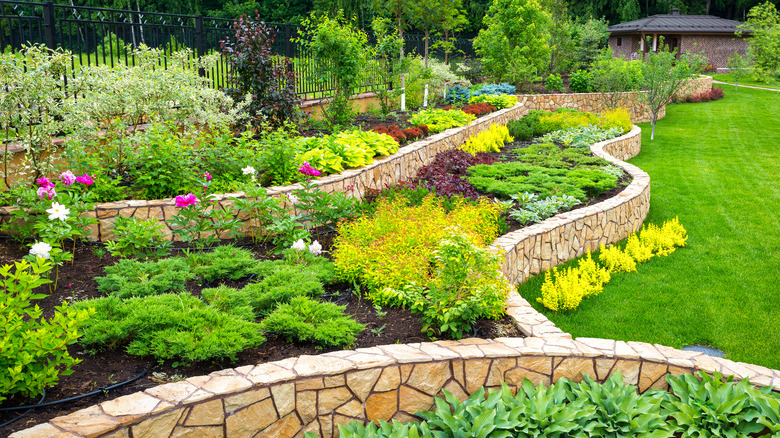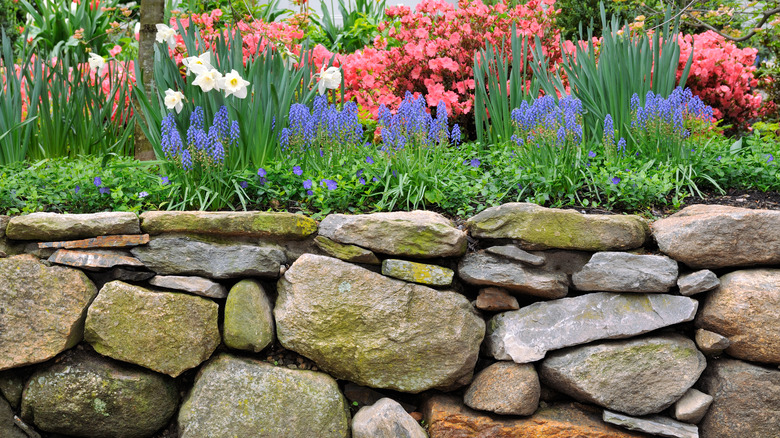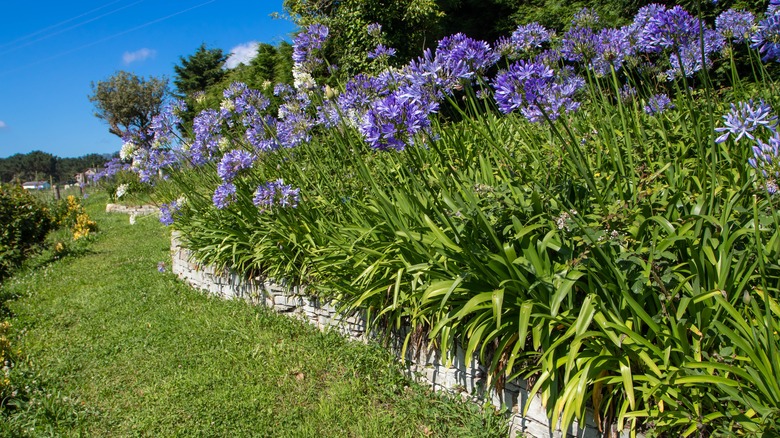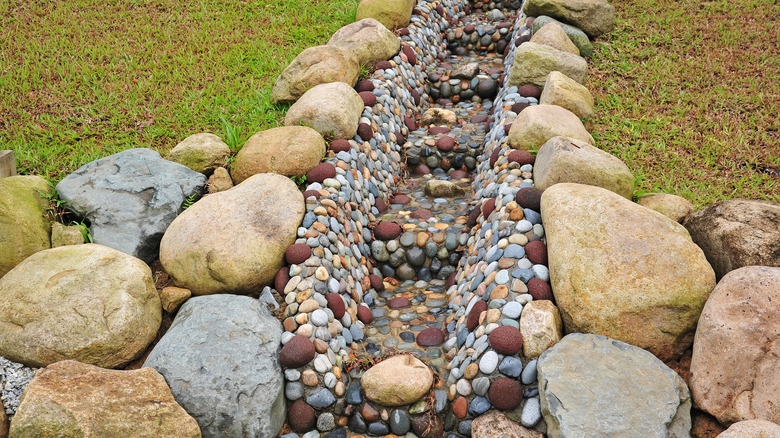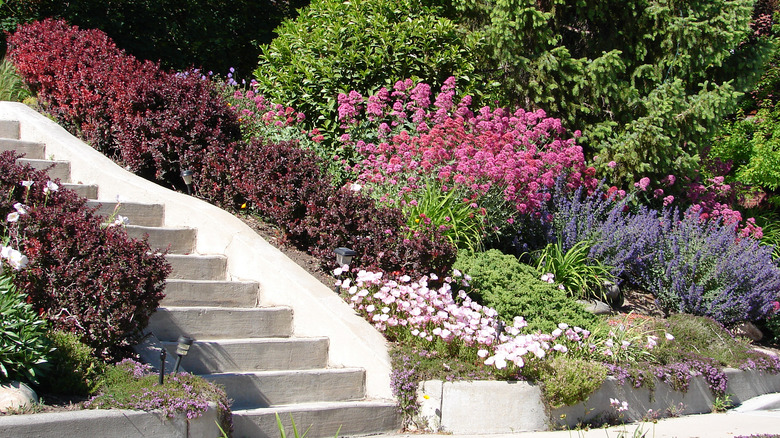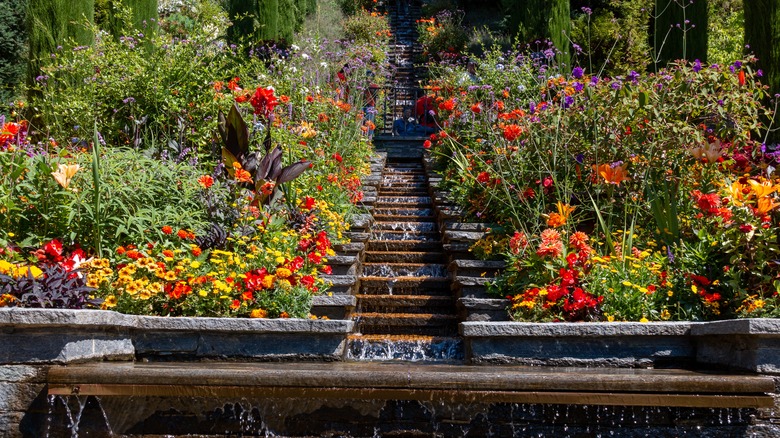5 Tips For Gardening On A Slope
If your home features a sloped garden, you probably know how difficult it can be to design, build, and maintain. There are countless ways to plan out a sloped garden, and there isn't necessarily a right way to do it. That said, there are several things that you will want to avoid as you choose plants, add interest, and build onto your sloped garden. This awkward space bears almost as many dangers as opportunities. Before you get started, you'll want to look out for things such as water runoff, erosion, and growing conditions, as taught by Mississippi State University Extension, but we'll get into that a little later.
For now, you should know that sloped gardens are awash with exciting possibilities. Depending on the climate you live in, your slanted yard can become the most beautiful tiered vertical garden filled with seasonal flowers or it can act as an informal garden area that ebbs and flows with an array of native plants that show off a soft, yet wild aesthetic. Before losing yourself to the sloped garden of your dreams, check out these five tips for creating a lovely sloped garden that is also easy to care for.
Build a barrier
Garden walls such as terraces and retaining walls are a great place to start when you plan to grow plants on a slope. Often, these barriers are necessary for a clean and cohesive look that will last for several years. Sloped gardens need level areas cut into them for easy access to the beds and to hold back the soil. Not to mention, these barriers can increase the value of your home. When you put up a retaining wall, it creates clear borders and slows soil erosion. By making good use of your sloped landscaping space, you can create a gorgeous garden that is beautiful, functional, and simple to maintain.
According to Bear Creek Landscaping and Construction, building a barrier can be tricky. You will need quite a few heavy-duty tools such as a plate compactor, a round point shovel, a square tip shovel, and more to get the job done. If you have experience in outdoor building projects, there are many resources online that go in-depth with each step needed to DIY your own retaining wall. Less experienced builders may consider hiring a local landscaping company for the project.
Choose the right plants
One of the most important tips for successfully growing a garden on a slope is to choose the right plants. Not every flower, herb, and shrub can handle the stress of growing on a hill. As mentioned by Greenwood Nursery, certain vining species and shallow rooting plants can be killed after heavy rainfall washes them down the slope. Still, many other plants grow beautifully on this difficult terrain. In particular, low-growing ground cover plants, ornamental grasses, small shrubs, and hardy perennials thrive in these areas.
As with any garden, you must consider the growing conditions on your slope. Note the sun exposure, soil moisture, soil type, and any cover from tall trees and structures, as recommended by Purdue University. When you know what you are working with, you can begin choosing the best plants to grow in that area. For shady garden plots, you can use wild ginger, bunchberry bushes, hosta plants, or lady ferns. In sunnier areas, plants such as Indian grass, catmint, spiderwort, and shrub roses survive well.
Consider water runoff
On a slope, water runoff can seriously damage your plants if it isn't accounted for. Heavy rainfall during any point in the year may subject your angled garden to erosion that leads to worse problems, as warned by Mississippi State University Extension. Water always chooses the easiest path down to the lowest level it can reach. Gardeners can use this to their advantage by constructing drainage channels for the water to follow. These channels can also be aided by a retaining wall and plants with tight root systems, which are created by shrubs, trees, and ornamental grasses. These plants naturally hold soil in place while simultaneously slowing down the water as it makes its way down the slope.
A few of these tight-knit plants are suggested by Jackson Nurseries and include geraniums, coneflowers, and hard rush. In fact, many low-growing shrubs, climbers, alpines, heathers, and grasses can do the trick in a sloping garden of almost any size.
Keep it simple and natural
When you're finally ready to head out to your local nursery and choose some of the plants we've already mentioned, take a second to think about the flora that is native to your area. All U.S. states have wonderful native perennials, which you can grow season after season with little maintenance. However, that isn't the only benefit. According to the East Multnomah Soil and Water Conservation District, planting native wildflowers and other plants makes your soil healthier, purifies the air around you, and allows you to use less fertilizer, water, and pesticides. Additionally, it will help the wildlife that lives around you as plants native to your region provide the insects and animals with shelter and food.
To keep it even simpler, consider growing lots of the same species and many low-maintenance plants. Sloped gardens are difficult to maintain as is. Try your best to minimize the work you have to perform on this garden each season.
Define perfection for your garden
Sloped gardens will never reach perfection the way that border gardens and vegetable gardens try to. These angled areas need a different version of perfection that focuses on the natural environment, unique use of space, and surprising opportunities. The perfect sloped garden uses its location, soil, and angle to its advantage. This can be achieved by adding one or more retaining walls, creating separation with paths and borders, or even by doing something more creative like adding a water feature to the middle of your slope, as suggested by Alda Landscaping.
Keep in mind that when you make these kinds of decisions, you need to consider how you will maintain the area. Most sloped gardens can not be mowed or weeded easily. Likely, you'll have to crawl up or down the hill to prune your bushes and deadhead your flowers. Each element you add will need to be tended to in some way. Be certain that you will have the ability to deal with the requirements of your garden every season before you pour your time and money into a new addition.

